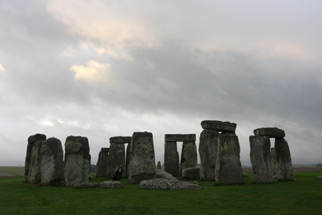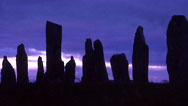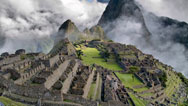Astronomy at Stonehenge?
- By David Levin
- Posted 09.30.10
- NOVA
In the 1960s, a new theory surfaced that claimed Stonehenge was the work of ancient astronomers, and that its giant stone pillars were used to predict eclipses of the moon and sun. But was there anything to the idea? To find out, we talked to NOVA's senior science editor, Evan Hadingham. He trained as an archeologist and has written two books on Stonehenge.
 Listen
Listen
An expert discusses the controversial question of whether Stonehenge was an astronomical observatory.
Transcript
Astronomy at Stonehenge?
Posted September 30, 2010
DAVID LEVIN: You're listening to a NOVA podcast. I'm David Levin. For centuries, the real reason why Stonehenge was built has been a mystery. Was it a monument to ancient kings? A place for ritual sacrifice? In the 1960s, a new theory surfaced that claimed Stonehenge was the work of ancient astronomers, and that its giant pillars were not just used to mark the summer and winter solstice, but to predict eclipses of the moon and sun. The idea was controversial. But was there anything to it? To find out, we talked to NOVA's senior science editor, Evan Hadingham. He's a trained archeologist, and has written a few books on Stonehenge.
DAVID LEVIN: Evan, thanks for speaking with me.
EVAN HADINGHAM: It's a pleasure to be here.
DAVID LEVIN: Can you describe what happened in the 1960s that really sparked this debate over astronomy at Stonehenge?
EVAN HADINGHAM: Sure. It came about on a specific day in 1961, when a Boston University astronomer, Gerald Hawkins, visited the site to photograph the famous sunrise at midsummer. And as he stood there in the middle of Stonehenge, he looked around at the pairs of archways, and he wondered if the stones could be marking other things in the sky besides the sun. When he got home, he fed a plan of Stonehenge into a huge mainframe IBM computer to see if the stones marked out on the plans pointed to the rising and setting points of other objects in the sky, such as specifically the moon.
DAVID LEVIN: So what did he find?
What came out of the machine surprised and excited him. He came out with about 24 alignments, that is, orientations where pairs of stones seem to line up or point to the settings and risings of the sun and moon in the sky. And he thought that number couldn't possibly be due to chance. So he developed the idea that Stonehenge had indeed been an astronomical observatory. And he pushed it even further. Using evidence at the site, he argued that Stonehenge had been used to predict warning times when the builders could have expected eclipses to appear in the sky.
DAVID LEVIN: Hm. That's a pretty bold claim...
EVAN HADINGHAM: Yeah, yeah. It's a very radical notion that the stone age people could have been capable of that.
DAVID LEVIN: Why did Hawkins think they'd want to predict eclipses?
EVAN HADINGHAM: He imagined that their priests would have wanted to know about eclipses in advance--in order, perhaps, to carry out impressive rituals where the moon would darken for a few hours at the high point of some ritual and reinforce their priestly power in the eyes of the multitudes gathered at Stonehenge. It's a great kind of movie image.
DAVID LEVIN: So how did people react to Hawkins' claim?
EVAN HADINGHAM: The idea that Stonehenge was some kind of stone-age observatory really took off in the popular--the public imagination, and Hawkins' book, "Stonehenge Decoded," became an instant bestseller. But to archeologists, this was kind of the last straw. The notion that you could use Stonehenge as kind of a slide rule, almost, to keep track of the cycles of the moon in order to predict eclipses just seemed totally far-fetched. And the theory was rejected out of hand by the chief archeologist of the British archeological establishment, Richard Atkinson, who had excavated Stonehenge in the 1950s.
DAVID LEVIN: Why was he so against the idea?
EVAN HADINGHAM: Atkinson's view was that Stonehenge was built by what he called "howling barbarians", who could not possibly have been capable of making advanced astronomical observations. There was no record that stone age people in Britain had any kind of number system, they certainly had no writing, their pottery and material goods were sophisticated up to a point, but the notion that you could have had a culture of astronomer priests predicting eclipses, doing mathematics and so on, was so out of left field that it completely blindsided the British archeological establishment, and they rejected Hawkins' theory out of hand.
DAVID LEVIN: But a few years later, another book came out that changed their minds entirely...
EVAN HADINGHAM: Yeah. That was published by a retired Oxford professor of engineering called Alexander Thom. And it turned out that professor Thom, since the 1930s, had been hiking all over the British Isles and sailing up the lochs of Scotland to survey the 900 or so other stone circles besides Stonehenge. And he came up with far more extraordinary claims than Hawkins made, that a true science of astronomy had been practiced in Britain some 4000 years ago. That their sky watching had been practiced at a truly mind-boggling level of precision, comparable to that of a modern astronomer. It looked like a sober academic study, and suddenly, the archeological community totally changed its attitude. They took Thom's work very seriously. and for a number of years, the notion that there were kind of stone age Einsteins operating in Britain really took hold.
DAVID LEVIN: So Thom really saw the builders of Stonehenge as ancient scientists?
EVAN HADINGHAM: Professor Thom never commented that much on what he thought motivated the builders of Stonehenge and other stone circles, but he was fond of saying, "oh, well, you know, the boys knew what they were doing," And in my mind, it was clear that he cast them as kind of white-coated technicians in his own mold. Because his approach to these stones was that of an accurate scientist. And he was measuring them on his surveys to within fractions of an inch. And he claimed that the ancient builders of these stones were doing the same thing. Problem is, think about a big 50-ton boulder and the problem of positioning it exactly to within, you know, tiny fractions of an inch. It's not really that plausible a claim.
DAVID LEVIN: Seems like there was a lot of back-and-forth over these ideas. Is that still the case? Where do most archeologists come down on this today?
EVAN HADINGHAM: I don't think anybody believes anymore that Stonehenge was some kind of fancy calculating device, kind of a Neolithic iPod with all of these apps that would allow you to figure out when the next period for eclipses would come along. But it is fairly well accepted that a less precise level of watching the sun and the moon almost certainly was done. That it was part of a ritual calendar system, that it was there to mark midsummer and mid winter, these key seasons in the agricultural calendar and the ritual calendar. I think that idea has actually gotten stronger.
DAVID LEVIN: Why do you think the astronomical theories were so popular in '60s? What's changed since then that has sort of tempered those ideas?
EVAN HADINGHAM: Well, [laughs] one of my favorite sayings was the British archeologist, Jacquetta Hawkes, who said, "every age gets the Stonehenge it needs or deserves". And back in the 60s, computers were very novel things, here they are being used to decode Stonehenge, and back then, in the 60s, people imagined Stonehenge as being built by essentially white-coated computer scientists like those that exist today. What's changed since the 1960s is a great advance in our archeological understanding of the culture and people of Stonehenge. And it's clear that they were not stone age Einsteins, but that they were very much preoccupied with rituals involving life, death, fertility, their ancestors, and that this time of midsummer and midwinter that is marked out by the stones of Stonehenge was crucial to their values and beliefs.
Credits
Audio
- Produced by
- David Levin
Image
- (Stonehenge)
- Courtesy Keith Rodgerson, © NOVA/WGBH Educational Foundation
Related Links
-

Secrets of Stonehenge
New archeological finds shed light on the most misunderstood monument of the ancient world.
-

Europe's Mysterious Megaliths
View a slide show of stone circles and other prehistoric ceremonial sites stretching from Scotland to Malta.
-

Riddles of the Sphinx
A marvel of ancient Egyptian engineering is threatened. Can it be saved?
-

A Marvel of Inca Engineering
Perched high in the Andes, Machu Picchu required ingenious construction, as engineer Ken Wright explains.
You need the Flash Player plug-in to view this content.

